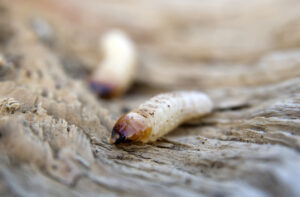
Need Help? Call Us On 0161 776 9832 For Expert Pest Control Advice on Identifying Pest Infestations And Help Solve Your Pest Problem.
Liverpool Woodworm Treatment Spray
Unlike with most other pests, a woodworm infestation is not caused by a specific creature. Instead, Woodworm is the term used to describe the larvae of several types of wood-boring beetles. In the U.K., a woodworm infestation is likely to be caused by the Common furniture beetle. Still, it may involve less common Deathwatch beetles and House longhorn beetles which require a more extensive Liverpool woodworm treatment.
Deathwatch beetles and House longhorn beetles have more giant grubs, which therefore cause more extensive damage to the timbers that they infest. In addition, their emergence holes are more significant and can weaken the infected wood more substantially.
- Beetles lay their eggs in cracks in wooden flooring, joists and furniture.
- Larvae hatch and tunnel through the wood, moving away from the surface to avoid detection.
- As the larvae mature, they move back towards the surface of the wood and emerge as adult beetles.
The feeding and burrowing of the larvae can cause significant damage to timbers. In extreme cases, this can cause the woods to become structurally unsound and become dangerous and likely to collapse, potentially causing substantial and expensive damage to your home. The presence of Woodworm also indicates typically the company of damp in the timbers, which again is a severe risk to their structural integrity and would require a professional survey to establish whether they need replacing.
In furniture, this could require a Liverpool woodworm treatment furniture product spraying.
Indications of a woodworm infestation:
 Woodworm usually doesn't attack polished or treated wood. The most obvious sign of an infestation is the presence of holes in timber. They will usually be oval or round and are caused by the mature beetles burrowing out of the wood. There will be a cluster of small holes for Common furniture beetles, usually around 2 to 3 millimetres in size.
Woodworm usually doesn't attack polished or treated wood. The most obvious sign of an infestation is the presence of holes in timber. They will usually be oval or round and are caused by the mature beetles burrowing out of the wood. There will be a cluster of small holes for Common furniture beetles, usually around 2 to 3 millimetres in size.- You may also see woodworm grubs which are a creamy white colour and curved in shape.
- When the larvae are feeding on the wood, they leave droppings called frass behind them. This looked like fine sawdust and was viewed under magnification. It can have a lemon type shape.
- The structural weakness of floorboards. Floorboards giving way could indicate the presence of wood burrowing pests which would require Liverpool woodworm removal treatment.
- Presence of dead beetles around wood. You may also see live beetles between May and October when they mature and emerge.
When signs of Woodworm are noticed, a comprehensive survey should be undertaken to assess the extent of the damage and determine whether the infestation is still active. Liverpool woodworm treatment spray would then be applied to the active infestation.
When the furniture is affected, non-insecticide treatment for woodworm removal is possible. These can include using heat. In this method of Liverpool, woodworm treatment may be heated to above 52 degrees Celsius for Common furniture beetles and Deathwatch beetles and held there for 8 hours. This will kill the Woodworm without the use of Liverpool woodworm treatment spray.

